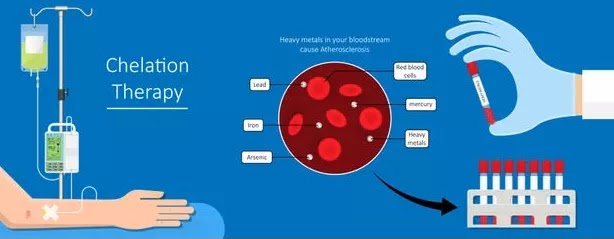What is Chelation Therapy?

Chelation therapy is a medical procedure that involves the administration of chelating agents such as EDTA to remove heavy metals from the body. This treatment is primarily used for metal poisoning, including lead, mercury, arsenic, and cadmium. The chelating agents bind to these toxic metal ions to form complex structures, which are then excreted from the body, typically through urination.
Theory Behind Chelation Therapy
The theory behind chelation therapy is that heavy metals, such as lead, mercury, and arsenic, can accumulate in the body and cause oxidative damage, leading to chronic diseases. The chelating agent binds to these heavy metals and removes them from the body through the urine. This is believed to improve overall health and reduce symptoms of the above-mentioned conditions.
Chelation therapy is typically administered intravenously, with a solution containing the chelating agent being slowly infused into the bloodstream. This treatment can take several hours and requires multiple sessions, depending on the severity of the heavy metal toxicity. The length of treatment and frequency of sessions can vary greatly, depending on the patient’s condition and response to therapy.
Approved Uses
The U.S. Food and Drug Administration (FDA) has approved chelation therapy for specific cases of heavy metal poisoning. It is also used in emergency situations for conditions like hypercalcemia (excessive calcium levels) and certain types of heart arrhythmias associated with digitalis toxicity.
Controversial and Unapproved Uses
Despite its established role in treating metal toxicity, chelation therapy is sometimes used for other medical conditions such as cardiovascular diseases, autism, and Alzheimer's disease. However, these uses are not supported by substantial scientific evidence and are considered controversial. The FDA and other medical organizations have not approved chelation therapy for these unproven benefits, and they caution against its use in such contexts due to potential risks.
Risks and Side Effects
Chelation therapy must be administered with care as it can have several potential side effects, including serious ones like death. The risks are particularly pronounced when the therapy is used improperly or for conditions where its efficacy and safety are not scientifically established. A study conducted by the National Institutes of Health (NIH) found that chelation therapy had no significant benefit for patients with heart disease. The study also noted potential risks and side effects of the treatment, including an increased risk of kidney problems and hypocalcemia (low calcium levels) which can lead to cardiac arrest.
Current Research and Perspectives
While some studies, like the Trial to Assess Chelation Therapy (TACT), have explored potential benefits of chelation therapy for heart disease, the results are not conclusive enough to support its routine use for such conditions. Further research is needed to fully understand the efficacy and safety of chelation therapy in non-approved uses.
Conclusion
Chelation therapy is an alternative medical treatment that involves the use of a chelating agent to remove heavy metals and minerals from the body. While it has been used for decades to treat heavy metal poisoning, its effectiveness for chronic diseases like heart disease and diabetes is still under debate. There is a lack of scientific evidence to support its use, and there are potential risks and side effects associated with this treatment. It is essential to consult with a healthcare professional before considering chelation therapy and to have proper testing and diagnosis to avoid any potential harm.

